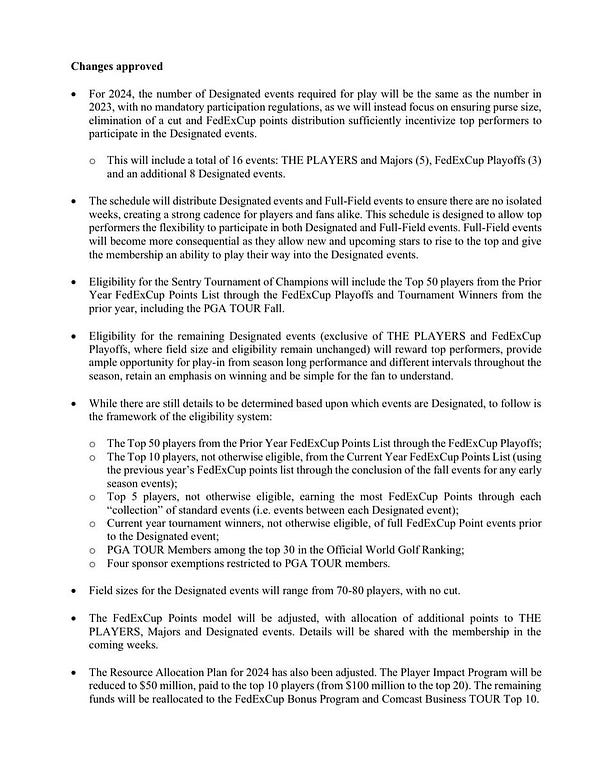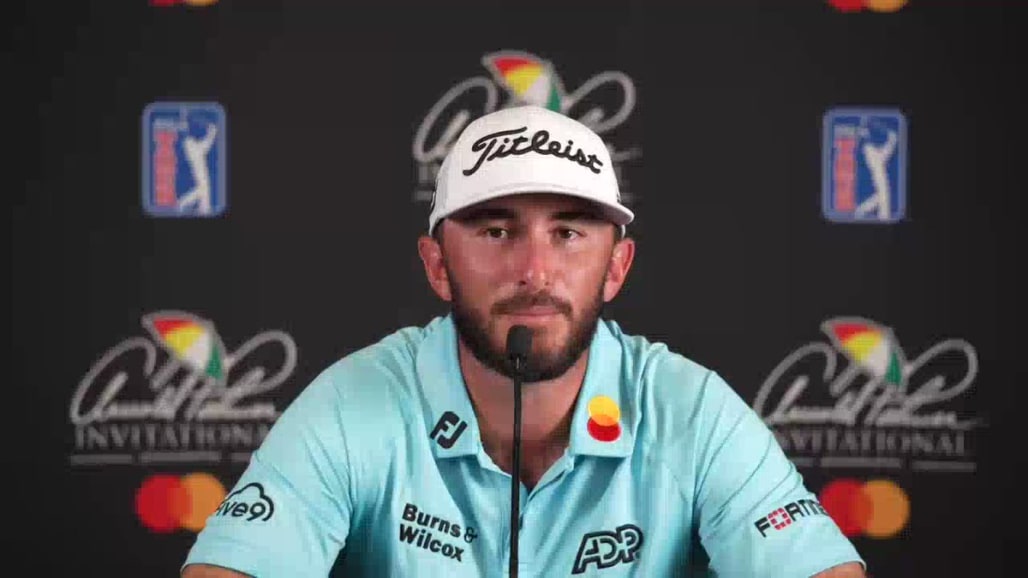A Thorough Review of the New PGA Tour Model
A New Era
The day has finally come. Last week, the PGA Tour unveiled a new model. Some information is still to be decided, but preliminary details about the new PGA Tour schedule have emerged.



From the day I started Finding the Edge two years ago, schedule reform has been the top item on my agenda.
Now that we have some details about the future of the PGA Tour, the majority of this newsletter will be an evaluation of what has been announced and what remains to be announced.
Warning: This explanation is long, but stick with it. I think you’ll come out the other side with a robust understanding of the new PGA Tour model and the factors that drove the decisions.
Some Background
To understand the paradigm shift that the new PGA Tour model represents, you first must understand why the shift was necessary.
Historically, the PGA Tour schedule has been a year-round collection of 40+ tournaments per season, each of which carries roughly the same weight. Win a huge tournament with a strong field? Nice, here’s a bunch of FedEx Cup points. Win a small tournament with a weak field? Nice, here’s almost the same number of FedEx Cup points.
FedEx Cup points serve two main purposes:
Crowning a season-long champion at the end of the season
Determining players’ eligibility/status each season
The structure I just described is an incentives nightmare. Since rankings are based on total points accumulated, players are incentivized to tee it up every single week, which is impractical. Traditionally, superstars on the PGA Tour have elected to play ~18-25 tournaments per year. Consciously or subconsciously, by playing fewer events than the entire schedule, players signal that winning the FedEx Cup is not their top priority. Their signal does not reflect a lack of competitive spirit or apathy towards their careers; it is physically impossible to play in every single tournament, which directly conflicts with the incentive structure.
Each season concludes with the Tour Championship, a thirty-player competition. The winner of this tournament is the FedEx Cup champion. For the sake of brevity, I won’t detail all the reasons why the Tour Championship is the worst championship format in all of sports. All you need to understand is that the season-long points system incentivizes players for playing as often as possible, and it also rewards players who play in weak fields. The system can be exploited; therefore, the integrity of the season-ending championship is diminished. Unsurprisingly, the Tour Championship is far from appointment viewing.
It’s easy to make fun of the Tour Championship. I do it all the time. It’s also easy to understand how the PGA Tour landed on such a foolish format for a season-ending finale. The root cause of the problem is that FedEx Cup points attempt to accomplish both bullet points I listed above: ranking the best golfers on the PGA Tour and serving as a qualification metric for all 200+ golfers on the PGA Tour.
There are special benefits to being one of the thirty golfers who qualifies for the Tour Championship, like receiving an invite to the Masters. At the same time, the Tour doesn’t want the 30th ranked player to win the Tour Championship. Hence, they created a format with a staggered start (i.e. the leader starts two strokes ahead of 2nd place and 10 strokes ahead of 30th place). The Tour Championship may not be the biggest problem the PGA Tour has, but it’s a perfect example of how the Tour’s infrastructure lacks cohesiveness, which leads to bad incentives and a poor entertainment product.
The points system can be gamed because the PGA Tour has refused to stratify their tournaments explicitly, which would be an admission to sponsors that some events are not as important as others. Until the Tour stratifies its tournaments, the schedule will lack cohesiveness.
Another massive shortcoming of the PGA Tour’s infrastructure is its failure to reward golfers proportionally to the value they bring to the PGA Tour. Sports are superstar-driven. If compensated based purely on market value, the top players on the PGA Tour would make much more money than the 100th best player on the PGA Tour, but the structure of the PGA Tour does not facilitate market-driven compensation.
I should call out that a key variable is the PGA Tour’s legal, tax-exempt classification as a member-run non-profit organization, in which policy changes must be ratified by the Player Advisory Council. It’s hard to pass policies that reward the superstar minority at the expense of the majority.
Piece all of this together and you have a model vulnerable to disruption.
Well, the threat came. It’s called LIV Golf. It has deep pockets and hundreds of hundreds of fans. And it wants to transform golf by offering a more efficient model and by luring superstars away from the PGA Tour with huge guaranteed contracts.
None of the PGA Tour’s susceptibilities are new. People like me have been sounding the alarm about the issues for a long time to no avail. But when LIV Golf knocked on the door, the PGA Tour finally felt the urgency to create a new model. Adapt or die. It’s easier to pass policy when faced with an existential threat.
The new model needed to accomplish the following goals:
Provide proper incentives for all PGA Tour players
Compensate the top players on the PGA Tour appropriately
Appease sponsors
Engage fans
Some goals are often at odds with one another, like appeasing sponsors and engaging fans. The CEO of Mastercard is literally the only person on the planet who wants to watch an interview of the CEO of Mastercard. Solving all of these problems is challenging and requires trade-offs. Not everyone is going to be happy with every part of the solution.
The best strategy for solving all of these problems is to focus on building the world’s most competitive platform for professional golf. Above all else, Competition must be the guiding principle.
Money will follow.
My Solution
I promise we will get to the Tour’s solution in a second. But to understand the Tour’s solution, it’s instructive to understand the rationale behind the solution I’ve continually proposed (The Fried Egg Golf Podcast - August 2022). I’ll cover it briefly.
My solution advocates divorcing ranking points from eligibility points. Instead of having one points system attempt to both rank players and determine eligibility, I’ve proposed having separate Playoff Points and Qualification Points lists. My solution features ~15 designated events, in which all of the top players in the world compete. The events would be identical to the designated events in this current PGA Tour season.
Under my solution, designated events would dole out both Playoff Points and Qualification Points. All other events on the PGA Tour would only dole out Qualification Points. Lower circuit tours (like the Korn Ferry Tour and PGA Tour Latinoamerica ) would also distribute Qualification Points in accordance with field strength. Qualification Points would be the international currency for earning status and entry into designated events on the PGA Tour.
By restricting Playoff Points to the tournaments with all of the top-ranked players in the world, we’d build a rankings system undiluted by points distributed at weak fields. This season’s standings would look like this:
My Tour Championship would only feature the season’s top eight points earners squaring off in a double elimination match play bracket. Head-to-head competition in which any qualified player deserves to be champion is a far superior format to the existing Tour Championship.
The benefits of my solution are clear. Superstars could play just the ~15 designated events without compromising their chances of winning the Tour Championship. My qualification system allows for merit-based fluidity throughout the golf ecosystem. Play well in non-designated PGA Tour events or in Korn Ferry Tour events and you earn your way into a designated event. Play well in designated events and you earn your way into the eight-golfer Tour Championship. Competition is foremost in my proposal. The incentive structure is clean. And the model facilitates superstars making a ton of money.
But my solution is a hypothetical solution that ignores some of the practical considerations the PGA Tour must consider when running a business non-profit.
The downsides to my plan are also evident. Why would a top player ever participate in a non-designated event? Why would a company pay to sponsor a non-designated event if there aren’t going to be any top players participating? Also, if you’re clearly not a Top 8 golfer but you’re anywhere between like the 10th and 120th best golfer in the world, what is motivating you to advance your status? You’ll qualify for all my designated events, but you’ll never make it to my Tour Championship. There are no levels in between.
Philosophically, my solution is pretty good. In implementation, it leaves room for improvement.
Without further ado, let’s get to the PGA Tour’s freshly-ratified model.
Spoiler: I think it has the potential to be much better than my solution.
The Designated Event Model
PGA Tour commissioner Jay Monahan refers to the new infrastructure as the Designated Event Model. The model is comprised of 16 Designated Events with 70-80 golfers in each tournament as opposed to the 120+ golfers in this season’s Designated Events. Controversially, the Designated Events will not have a cut. Every participant competes for all four days.
I’m simplifying a little, but to earn your way into the Designated Events, you’ll either need to be ranked in the Top 50 of the previous season’s FedEx Cup standings or have had success leading up to the Designated Event.
My initial reaction to the details was very negative. I didn’t like that the Designated Events are only going to feature 70-80 players, and I didn’t like that those events won’t have cuts. After reading and listening about the changes, I’ve reevaluated my position.
The Good
On the No Laying Up podcast, Player Advisory Council member Peter Malnati addressed my field size concern. He explained that if fields were larger than 80 players, the FedEx Cup standings would mean less. Finishing within the Top 50 of the FedEx Cup standings guarantees entry into all of the next season’s Designated Events. By limiting available spots in the most prestigious events, the season-long race is elevated, which gives fans something exciting to track throughout the season.
If tournaments had 120+ players in each field, gaining entrance into the tournament would be much easier, and that would diminish the value of being within the Top 50 of the FedEx Cup standings. Additionally, only having 70-80 players per Designated Event leaves a wealth of talent to compete in Non-Designated Events. Those playing in the Non-Designated events are competing to earn a spot in the Designated Events. Non-Designated events will be compelling, which enables the Tour to find companies to sponsor them. Field reduction is a brilliant decision.
Oh, also the Tour is reducing the Player Impact Program from a $100M prize fund to a $50M prize fund, so it’s only $50M too large now.
The Bad
Designated Events should have a cut. I’m gravely disappointed that some of the Tour’s most prestigious events will not have a cut. Cutlines introduce intensity and context. Tiger Woods’ Thursday round at the 2023 Genesis Invitational was one of the most captivating non-major championship golf rounds of the last few years. The round wasn’t just exciting because Tiger played well; it was exciting because Tiger was within the cutline while worse-performing players faced the possibility of being sent packing after two days. A cutline delineates a good week from a bad week. It also leaves a trail of historical context.
A player should not be able to play badly for three days and then shoot up into 20th place after one super low fourth round. As long as that outcome exists, fans will care very little about who finishes between 20th and 80th place. They’ll also be much less engaged in Thursday & Friday rounds since the only engaging storylines will occur at the top of the leaderboard. I have serious concern that by removing a cutline, the Tour may have cheapened some of the best tournaments on the PGA Tour schedule, which would be a catastrophic failure.
The counterargument is that sponsors and fans want assurance they’ll see Tiger Woods on Sundays. I saw a Norwegian man tweet that if he’s going to travel all the way to the United States to watch a tournament, he’d value the assurance that Viktor Hovland is playing on the weekend. That fan’s voice and dollars matter.
Guaranteeing four days of play also makes travel easier for players, caddies, coaches, etc. These are valid considerations.
However, competition must be the guiding principle, and I believe absence of a cutline compromises the competitive integrity of an elite golf tournament. The Masters features fewer than 100 players each year and cuts down to the Top 50 players after two rounds.
Designated Events should have a cut.
The Unknown
The crucial unknowns are how FedEx Cup points will be distributed and potential reform to the Playoffs/Tour Championship. I cannot fully evaluate the schedule until these details are published.
The following two criteria must be met for me to approve of the new model:
Top players cannot be incentivized to play in as many tournaments as possible
Every participant in the Tour Championship must be worthy of being crowned season-long champion
If the Tour sticks with one points system that distributes points at every tournament on the PGA Tour, the incentive remains for players to compete in as many tournaments as possible. Adjusting point totals for the strength of the field is not a good solution. Even if a Non-Designated Event only gives 100 points to the winner while a Designated Event gives 500 points to the winner, the incentive remains to play in both tournaments. Not ideal.
And if the Tour Championship continues to have 30 participants, it will continue to be the worst championship format in all of sports, which undermines the entire schedule. All due respect to the 30th best golfer on the PGA Tour, but if you had the 30th best season, you should not have the opportunity to win the Super Bowl. Full stop.
Summary
Overall, the PGA Tour’s changes are extremely encouraging.
The Tour’s Designated Event Model philosophically aligns with the solution I’ve been proposing, and it improves upon some of the shortcomings of my solution. The solution also removes mandatory participation regulations, a significant indicator of proper incentive alignment.
I am pumped that the schedule facilitates competition and provides proper incentives. I am upset that cut lines will diminish the competitive intensity of golf tournaments. And I am skeptical about what the Tour will announce with respect to the points system(s) and the Tour Championship.
The new model is directionally correct, and the Tour deserves credit for moving in the right direction.
Lastly, I want to express my respect for the leaders of the PGA Tour like Rory McIlroy and Max Homa who understand the importance of communicating the changes from their perspectives. Your candor and thoughtfulness is appreciated.
Golf Reference Site
A golf reference website should exist. Golf fans should be able to query things like “What’s Rory McIlroy’s best opening round in the Masters?”
I’m pleased to announce that Kyle Porter and I are building it. We have a vision, and the website will eventually be much more than a data querying tool. I’m pumped about the site because it’s going to tell the story of golf, and it is going to be valuable to you.
If there are certain features you’d like to see on the website, we’d like to hear from you. Your perspective is valued.
Contact/Feedback
Email: Joseph.LaMagnaGolf@gmail.com
Twitter: @JosephLaMagna
Other Recent Content
I’m writing more regularly for The Fried Egg this year. Some of my work is behind the Club TFE paywall. This is the only paywalled content to which I’ll consistently link because I think Club TFE (and independence) is important to golf and a Club TFE membership is valuable, in my opinion.
My Club TFE post on what makes a good short par 4 for pro golfers
My Club TFE post on why Bay Hill is arguably the least interesting golf course on the PGA Tour
Excellent (free) Stratechery piece. It’s titled “What the NBA Can Learn from Formula 1” but I cannot recommend it more highly to people involved in golf. Read it.
Memphis Grizzlies star Ja Morant livestreamed himself with a gun at a nightclub this weekend. He’s also been linked to other troubling stories. I really enjoyed this clip from Jalen Rose:
The No. 1 tennis player in the world, Novak Djokovic, has been denied entry into the United States based on his vaccination status. Not everyone thinks he should be denied to play Indian Wells.


It doesn’t get much funnier than Charles Barkley:
The best:









